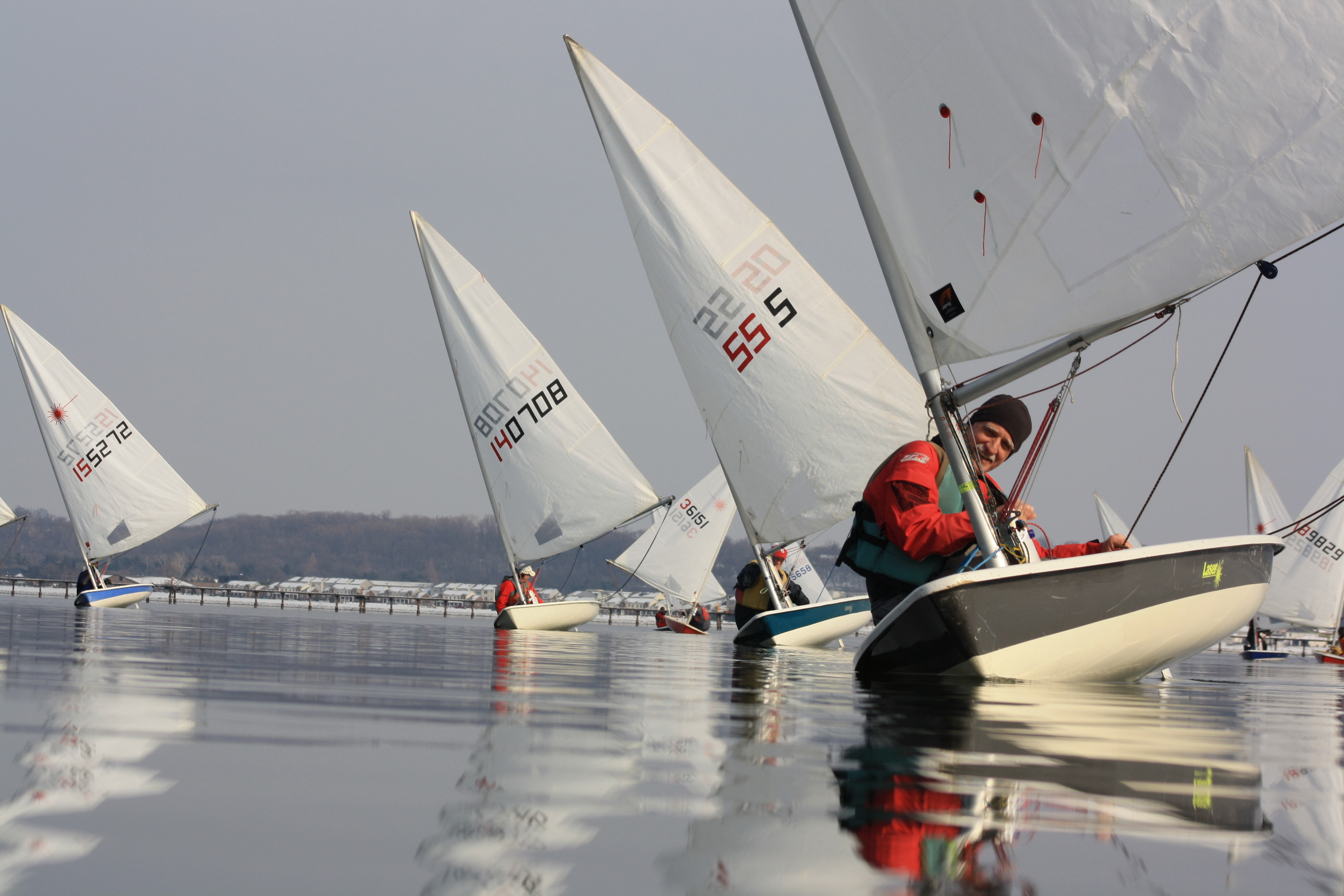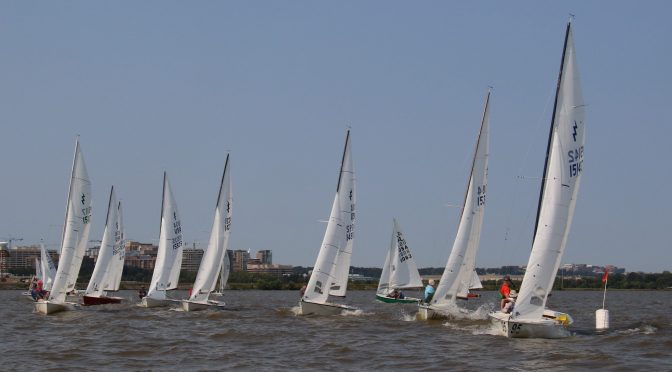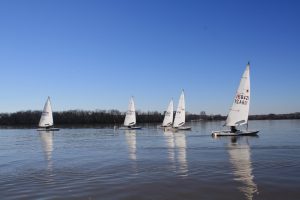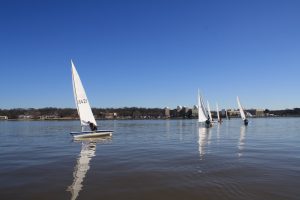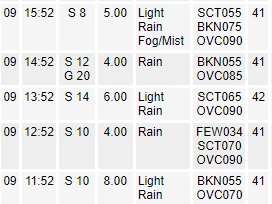Jim Klein and Kevin Cowley ran RC. They and the sailors had a long discussion about whether it was safe to go out. In the end they and 11 sailors did go out.
The winds where in the high teens (white caps were not constant) and gusts were up in the 20s. The air and water temperatures were similar — mid 40s. Colds hands were an issue for several sailors — we need to compare our methods of keeping hands warm. Capsizing and hard hiking was tiring.
Conditions at Reagan National Airport:
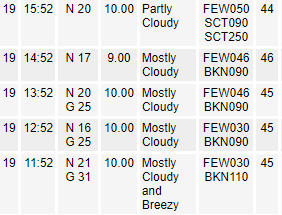
Results:
LaserFrostbite2122_5
Thoughts from Mike Renda
Well, the wife took the kids and went to NY this morning, and the weather forecast was for 45F and gusts in the low 20s. Seemed like a good day to get out and go sailing. Anyways, some thoughts.
On the water, my mantra is this on days like this: 90% fast, 100% of the time. In general, this focuses on minimizing mistakes, avoiding problematic situations and risk, thinking ahead, and keeping good boat speed.
Racecourse: My general observation is that I think there were better puffs out left. Current didn’t really seem to be a factor, or at least I didn’t really think about it. There were small gains on shifts to be had, but tacking on them required a bit of calculation to determine if the shift was big enough to warrant the extra tack (tacking too much on a breezy day can be slow, and the course wasn’t really long). I believe most of my first beats were: start at boat, go left until near port layline, tack on port, tack back on starboard when on layline with about 2-4 boatlengths to the mark.
Pre-start: I believe the boat was increasingly favored throughout the day (though never that much). My general approach on days like this is to err on being near the boat, with a focus on getting off without a hitch (low risk). Vang should be loose in case you need to duck / maneuver, though drastic moves should be avoided — no gybing. Also, I try to keep my head out of the boat a bit and avoid starting near crowds of boats (again, trying to avoid big problems). Outhaul & cunningham should be set for upwind mode (in lighter breeze I’ll start with them looser). Finally, on these breezy days, when the fleet sits and waits for the last 30 seconds, nobody ends up quite on the line, as everyone drifts downwind and gets going too late. Trim up a touch early and take advantage.
Upwind: In general, vang was at least two-blocked, outhaul near the end of the boom, and cunningham pretty much as tight as you can get it. Once going, I try to keep the main two-blocked as much as possible, easing in the puffs when needed. Body position, I’m focusing on getting my weight outboard and forward to keep the bow down. The laser does really poorly when healed up, and you should really do whatever you can to avoid the big heels in the puffs. I also focus on trying to keep the bow knuckle touching the water. Every time the bow gets picked up by a wave, you’re getting tossed off the wind, losing forward progress. I also think it’s important to find a body position that you can hold for most of the leg rather than be consistently resetting. Once you’re set, your head can focus on the sail, boats around you, and the puffs. When the sail gets really flat on days like this, the groove gets really narrow, so I find that getting set bodywise can help eliminate a variable and allows me to more easily find the groove via the rudder and mainsheet.
Windward mark: It’s really important to be able to ease and turn the boat downwind at the windward mark. Get your vang off early (do what you can to make this happen). Having the vang line tied to the centerboard is a really good idea, as you can more easily reach it when hiked (and the end never ends up to leeward). As I approach the windward mark, I reach down at the mainsheet block and make sure I can let the mainsheet slide through my hand as I raise it up above my head. This ensures I can ease the mainsheet a good 6 feet as I turn downwind without hitting any knots. Once turned downwind, I always tighten the hiking strap — this is extremely important. Once tight, wrap your aft leg around it (when on starboard, this is your left leg). This will help you physically control the boat through the waves with your bodyweight, as you are effectively tying yourself to the boat.
Downwind runs: With your aft leg wrapped around the hiking strap, your front leg / knee can be used to help get the boat up on waves. Lean forward, put your knee on the diagonal part next to the centerboard slot, and lean back once your boat hops up on the wave. I thought the runs were particularly well aligned to the waves for small periods of surfing. I did a bit of the “wave carving” business, but I’m not very good at it, and again, safety / stability is a paramount concern. It’s important to be looking backwards every 15 seconds or so to look for puffs.
Leeward mark: Get your boat setup for the upwind leg. Board down, cunningham tight, vang tight, outhaul tight, hiking strap back to loose. Turn the boat upwind (even if you don’t have the main trimmed) right at the mark so that you’re in as high of a lane as possible (“wide, then tight”).
Final leg strategy: If you round right behind someone, tack off and make them cover. Stress them out and make them make mistakes in the breeze. If they’re responding to your move, they’ll never tack as well as they can. This applies on light air days as well.
Between races, I’m always thinking about how I get the blood flowing again. Hiking contorts your body up and limits blood flow to the legs. I think it’s important to stand up between races and get the blood moving around. Pro tip: Leave a thermos of hot chicken noodle soup on the committee boat for between races. Be sure to provide RC with beer afterwards.
Nice racing Steen, and thanks to Jim & Kevin for RCing. Good seeing everyone, and happy holidays to all.

